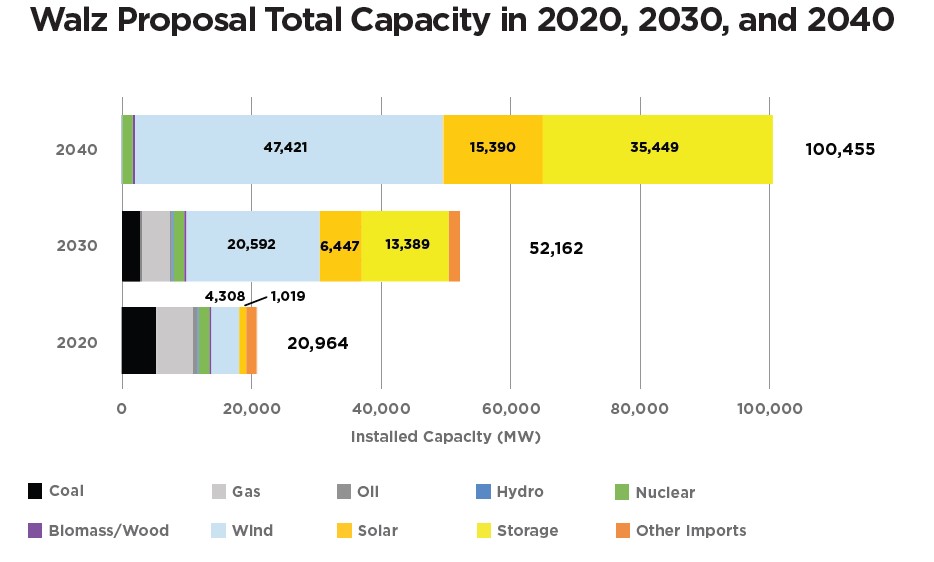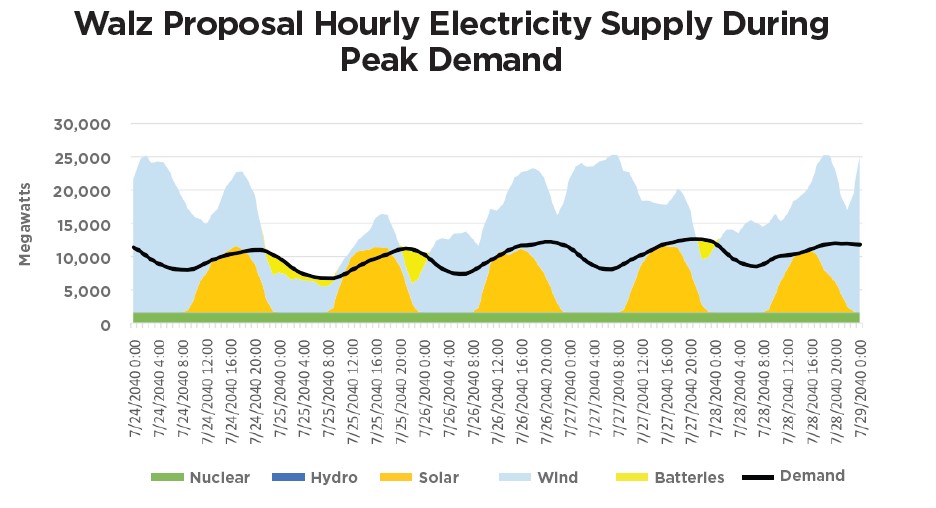Part 2: The Walz Proposal requires a massive buildout of wind turbines, solar panels, and battery storage capacity
In Part 1, we discussed how the Walz Proposal would dramatically alter where Minnesotans get their electricity. In Part 2 of this series, we will discuss just how much wind, solar, and battery capacity would be needed under Governor Walz’s plan to impose a 100 percent carbon-free electricity mandate in Minnesota by 2040.
Click here to view other installments in the series.
Matching Minnesota’s electricity supply with demand
Before we discuss how much wind, solar, and battery capacity would need to be built under the Walz Proposal, we need to take a step back and explain how our electricity system works.
The most important thing to know about the electric grid is that the supply of electricity
must be in perfect balance with demand at every second of every day. If demand rises
as Minnesotans turn on their air conditioners, an electric company must increase the
supply of power to meet that demand. If companies are unable to increase supply to
meet demand, grid operators are forced to cut power to consumers to keep the grid from
crashing.
Generating more electricity is relatively easy with dispatchable power plants — plants
that can be turned up or down on command — like those fueled with coal, natural gas, and nuclear fuel. But adjusting to second-by-second fluctuations in electricity demand is much more difficult with wind and solar, whose electricity production is dependent on second-by-second fluctuations in the weather.
As a result, it is much more difficult to provide reliable power as we become more reliant upon wind and solar to meet our energy needs.
It is possible to mitigate some of the inherent unreliability of wind and solar by vastly increasing the amount of wind and solar capacity on the grid (known as “overbuilding”
wind and solar installations) to allow electricity demand to be met even on cloudy or low-wind days, and curtailing, or turning off, much of this capacity when wind and solar production is higher.
It is this “overbuilding” and curtailing that leads to the massive buildout of wind, solar, and battery storage capacity in the Walz Proposal.
A massive buildout of wind turbines, solar panels, and battery storage capacity
In our study, we determined that Minnesota’s peak hour of electricity demand was about 13,800 MW in 2021. To meet this demand Minnesota relied upon 20,964 MW of power plant capacity from a diverse portfolio of generators, including coal, natural gas, oil, hydro, nuclear, biomass, wind, solar, and imported electricity.
Of this 20,964 MW of power plant capacity, 5,327 MW is either wind or solar, meaning there is 15,637 MW of reliable capacity on the grid to meet Minnesota’s demand of 13,800. This means there is more than enough capacity to keep the lights on regardless of weather conditions.
This changes dramatically in Walz Proposal, where the amount of power plant capacity would need to grow to 100,455 MW, a nearly five-fold increase, to meet Minnesota’s electricity demand for every hour of 2021 based on real-world wind and solar electricity data obtained from the U.S. Energy Information Administration.

Why so many wind turbines, solar panels, and batteries?
The massive overbuild is needed because sometimes wind turbines and solar panels produce a lot of electricity, but other times they don’t.
The graph below shows a hypothetical Minnesota’s in 2040 if the Walz Proposal were enacted. The data in the graph are real-world electricity demand figures for Minnesota in 2021, and the wind and solar values are based on 2021 real-world wind and solar capacity factors on the regional electric grid, the Midcontinent Indepdendent Systems Operator.

Wind and solar generation fluctuate based on wind speeds and available sunlight. The batteries, shown in yellow, fill in the gaps when demand exceeds the supply of wind and solar energy available. Any wind and solar power that exceeds the black line is either used to recharge the batteries, or is curtailed, or turned off.
The masssive overbuilding of the grid to meet electricity demand is incredibly expensive, which we will discuss in Part 3.